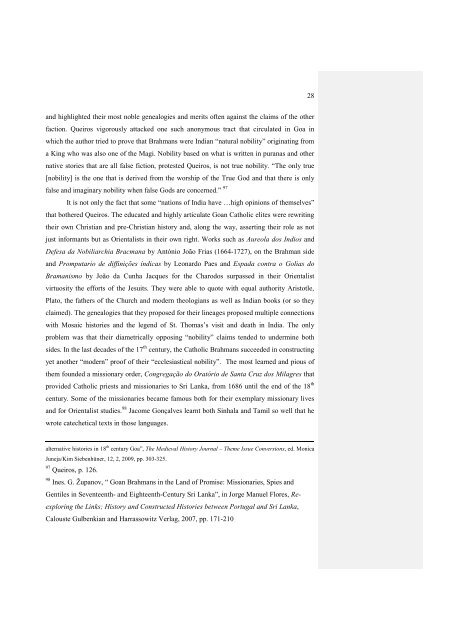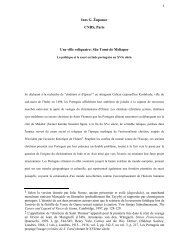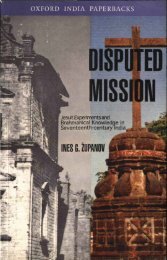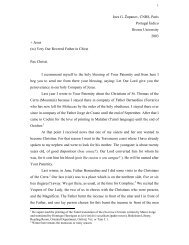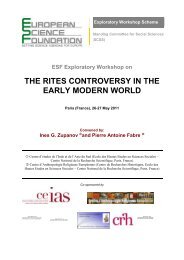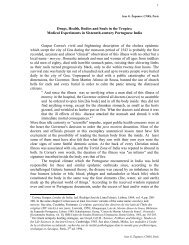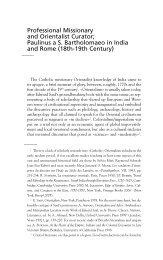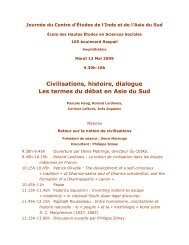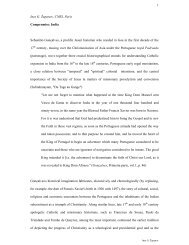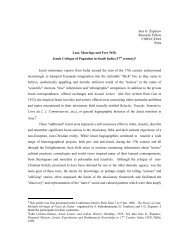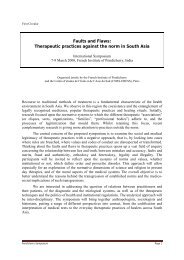Jesuit Orientalism; - Ines G. Županov
Jesuit Orientalism; - Ines G. Županov
Jesuit Orientalism; - Ines G. Županov
Create successful ePaper yourself
Turn your PDF publications into a flip-book with our unique Google optimized e-Paper software.
28<br />
and highlighted their most noble genealogies and merits often against the claims of the other<br />
faction. Queiros vigorously attacked one such anonymous tract that circulated in Goa in<br />
which the author tried to prove that Brahmans were Indian “natural nobility” originating from<br />
a King who was also one of the Magi. Nobility based on what is written in puranas and other<br />
native stories that are all false fiction, protested Queiros, is not true nobility. “The only true<br />
[nobility] is the one that is derived from the worship of the True God and that there is only<br />
false and imaginary nobility when false Gods are concerned.” 97<br />
It is not only the fact that some “nations of India have …high opinions of themselves”<br />
that bothered Queiros. The educated and highly articulate Goan Catholic elites were rewriting<br />
their own Christian and pre-Christian history and, along the way, asserting their role as not<br />
just informants but as Orientalists in their own right. Works such as Aureola dos Indios and<br />
Defesa da Nobiliarchia Bracmana by António João Frias (1664-1727), on the Brahman side<br />
and Promputario de diffinições índicas by Leonardo Paes and Espada contra o Golias do<br />
Bramanismo by João da Cunha Jacques for the Charodos surpassed in their Orientalist<br />
virtuosity the efforts of the <strong>Jesuit</strong>s. They were able to quote with equal authority Aristotle,<br />
Plato, the fathers of the Church and modern theologians as well as Indian books (or so they<br />
claimed). The genealogies that they proposed for their lineages proposed multiple connections<br />
with Mosaic histories and the legend of St. Thomas‟s visit and death in India. The only<br />
problem was that their diametrically opposing “nobility” claims tended to undermine both<br />
sides. In the last decades of the 17 th century, the Catholic Brahmans succeeded in constructing<br />
yet another “modern” proof of their “ecclesiastical nobility”. The most learned and pious of<br />
them founded a missionary order, Congregação do Oratório de Santa Cruz dos Milagres that<br />
provided Catholic priests and missionaries to Sri Lanka, from 1686 until the end of the 18 th<br />
century. Some of the missionaries became famous both for their exemplary missionary lives<br />
and for Orientalist studies. 98 Jacome Gonçalves learnt both Sinhala and Tamil so well that he<br />
wrote catechetical texts in those languages.<br />
alternative histories in 18 th century Goa”, The Medieval History Journal – Theme Issue Conversions, ed. Monica<br />
Juneja/Kim Siebenhüner, 12, 2, 2009, pp. 303-325.<br />
97 Queiros, p. 126. <br />
98 <strong>Ines</strong>. G. <strong>Županov</strong>, “ Goan Brahmans in the Land of Promise: Missionaries, Spies and<br />
Gentiles in Seventeenth- and Eighteenth-Century Sri Lanka”, in Jorge Manuel Flores, Reexploring<br />
the Links; History and Constructed Histories between Portugal and Sri Lanka,<br />
Calouste Gulbenkian and Harrassowitz Verlag, 2007, pp. 171-210


